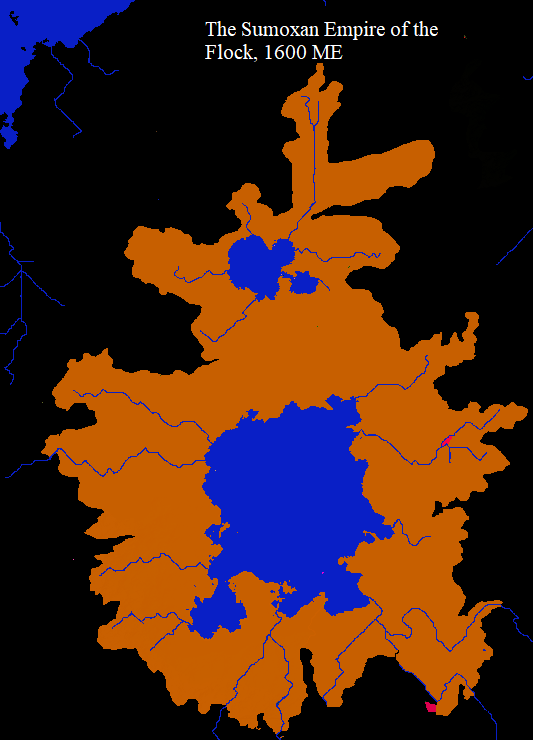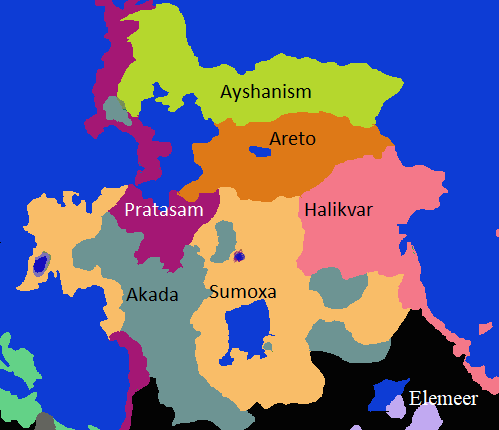Sumoxa
Sumoxa, ominously known as the Temple of the Dark Sun, is a religion of purposeful contradictions. Its hymns are often paradoxical and its festivals gleefully mix the profane and the sacred. Sumoxa redefines truth itself, rejecting a shared reality for all beings. It is the ultimate repudiation of Samvaran religion: rather than reject other religions as false, it seeks a universalism necessary to absorb all of them.
The theology, ethics, and worldview of Sumoxa are built on the teachings of two great philosophers: the ancient Dhampire-monk Moxima Sutia and the much more recent Virtue Seraja, grandchild of Aysha. That said, the faith borrows generously from the religions of Areto, Ayshanism, Halikvar, Pratasam, and Elemeer. It also validates and incorporates local religion into its theology. There is not one Sumoxa, there are many.
As an organization, Sumoxa is extremely regionally diverse. Gods and philosophies can vary from temple to temple, though the core tenets are usually the same. Theoretically there is a single unifying leader known as the Grand Shepherd, that is supposedly destined to unite all religions together under one banner. The Grand Shepherd has been a political puppet for several centuries though, leaving the local priests to guide themselves. Sumoxa's decentralization is actually very attractive for many political leaders that want the boons of a religious community without having to answer to anyone. Unlike Halikvar, Areto, or Pratasam, Sumoxan priests also don't need to be druids- though many do practice some kind of magic, as many Samvarans see magic use as a form of divine legitimacy.
If one were to try and summarize Sumoxa's central message, it would be: the world is incredibly ambiguous and ever-shifting, with many gods and universes colliding and transforming. You cannot comprehend the world, so instead focus on mastering yourself- preventing pain by containing your expectations, mastering your self-control, and focusing on your present moment.
Structure
Sumoxa has three basic levels of authority:
- The Upper Echelon, that directs the faith as an international network/organization
- State Echelons, that manages state-wide Sumoxan faith
- Lower Echelons, that manage local worship
Culture
Species Preference: Local Custom Rules
Individualism as Fashion
History
Virtue's Revelations
The Great Invasion
Modern Sumoxa
Mythology & Lore
The Revelations of Moxima
The Revelations of Seraja
Cosmological Views
In Sumoxa, all Gods are True, all heavens exist, and in some time or place every superstition is correct. Not everything is true for everyone all the time, of course. But generally speaking if people believe it, it is probably out there someone. While this may strike people in our world as ridiculous, Sumoxa exists in a world with many strange localized effects, immortals, and magicians. Rather than attempt to somehow order the vast strangeness of the world, Sumoxa simple accepts it all.
This worldview is extremely at odds with the other Samvaran religions, which consider accurate cosmology to be a matter of spiritual life or death. It is this firm opposition and dogmatic boundary-making by surrounding states that allows Sumoxa to remain coherent and unified despite its fluid worldview.
Tenets of Faith
- Have Control of Your Mind: It is easy for the unconditioned mind to get lost in the chaos of reality. This will only cause you pain. Give up on truth. Leave behind your entitled demands that the world make sense or that it come to order. You cannot impose your limited views on the world. Instead, leave behind those emotions which create this pain: your pride, revenge, greed, envy, hate, and desire. By mastering mental and emotional control, you can transcend pain and see the world as you were meant to see it.
- Have Control of Your Body: Your body affects your mind. It is the conduit between the divine chaos and your sheltered soul. You must master it, or you may lose your mental discipline. Overcome pain, hunger, and petty needs.
- Make Peace With The World: The world only seems bad because you define it that way. Once you let go of your petty pride, you can make peace with the world and greet it as a friend.
- Love Unconditionally: You cannot truly know the people you love. Family, lovers, friends, Gods, strangers all are worthy of love but you will never understand them. Practice love without purpose, conditions, or ego.
- Judge Not: Judgment is a sign of infantile pride. All people are strangers, so all strange and alien things are not different from your friends. All beliefs are true, all customs are valid, all creatures can be good.
- Justice is For Gods: Earthly justice is an illusion that will never satisfy your limited mind. Punishments exist to restrain future harm, not to pay some invisible debt.
- There is no Truth, Only Love: The world is fundamentally good, made of the pure love of the Godsource. Treat the world with love and you will be closer to the Godsource. Even if it seems non-sentient, treat it gently.
Ethics
Morality in Sumoxa is extremely individualistic and based around consent and intent. As the world is fundamentally unpredictable and uncontrollable, all forms of utilitarianism and consequence-based morality are shunned by Sumoxan writings. Instead, a very strict morality of personal intent is encouraged: one must choose to be as deliberate as possible and with that deliberate self-control choose what is immediately dutiful and just. Goodness seeks no gain but goodness itself.
Sects
The Eternal Apostles: A holy order of Solars, often disillusioned Ayshans, that act as the personal guard and messengers of the Grand Shepherd and Virtuous Council. Experimental, ascetic, elite warriors, willing to adopt new technology and magic, loyal only to Shepherd. "New technology" for solars includes ranged weapons, chemical weapons, and horse-riding. The Eternal Apostles are really the last major political instrument of the Upper Echelon for enforcement and mediation.
"There is no truth, there is only love"
Founding Date
1400 ME
Type
Religious, Organised Religion
Alternative Names
The Temple of the Dark Sun
Demonym
Sumoxan
Permeated Organizations
Deities
Divines
Location
Related Ranks & Titles
Notable Members
Tension
Remove these ads. Join the Worldbuilders Guild







Comments